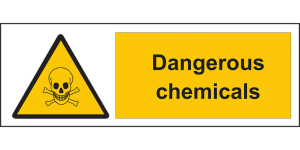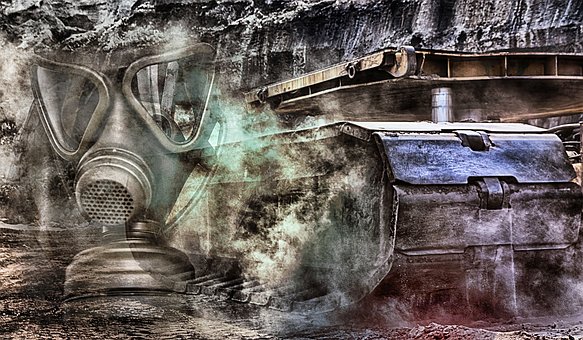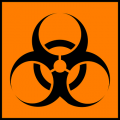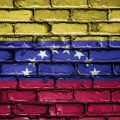De Faakto Intelligence Research Observatory
Modern Chemical Weapons-A Basic Primer
Methodology-OSINT research
Background & Summary
The U.S. Army Medical Research Institute of Chemical Defense defines a chemical weapon as, “A chemical substance…intended for use in military operations to kill, seriously injure, or incapacitate humans (or animals) through its toxicological effects.” Modern Chemical Weapons were first deployed in World War I by German Forces in Ypres, Belgium. By the end of WW I, chemical weapons caused 1.3 million casualties and approximately 100,000 fatalities. Since the introduction of modern Chemical weapons in the Great War, chemicals have been used in WW II, the war in Vietnam, the North Yemen Civil War, the Iran Iraq War, and most recently the War in Syria. The “Geneva Protocol” prohibits the use of chemical and biological weapons in the field of conflict. The protocol does not regulate the production, research or stockpiling of chemical weapons. The protocol does not govern the use of chemical weapons in domestic conflict (Civil War), nor are countries prohibited from retaliating with chemical weapons should an adversary attack with chemical weapons. Weaponized chemicals are classified as, Blister Agents (vesicants), Nerve Agents (Organophosphates), Choking Agents (Pulmonary/Lung), Blood Agents (disrupt oxygen carrying mechanism) and Riot Agents (temporary incapacitation). Chemical weapons are delivered in two phases. The delivery phase carries the agent to the target and the dissemination phase disperses the chemical onto the desired target. Delivery mechanisms include ballistic missiles, air dropped gravity bombs, rockets, artillery shells, aerosol canisters, land mines and mortars. Dissemination is accomplished through explosive detonation, which expel chemical laterally and alternatively aerodynamic dissemination, a non-explosive which deploys the chemical agent through dispersion lines.
Historical Timeline of Modern Chemical Weapons
1914-1918
World War I
Chemical weapons cause
- 3 million Casualties (Science History Institute, 2015)
- Estimated 90,000 to 100,000 fatalities, primarily from phosgene gas
German military uses chemical weapons-22 April 1915
- The first large-scale use of chemical weapons in war at Ypres, Belgium
- Approximately 170 metric tons of chlorine gas
- 5,730 chlorine cylinders are buried along a four-mile stretch of the front
- More than 1,100 people are killed by the attack and 7,000 are injured (Science History Institute, 2015)
1939–1945
World War II
- Poison gases are used in Nazi concentration camps to kill civilians
- Japanese forces in Asia used mustard and Chloroacetophenone (CN) gases and are suspected of using lewisite (Grunden, 2017)
1961–1971
Vietnam War
The United States
- Deploys Agent Orange & Napalm (Science History Institute, 2015)
- Agent Orange-Herbicide Agent- tactical herbicide removes dense foliage, destroys enemies cover, causes a myriad of long term health problems
- Napalm-incendiary firebomb fuel gel mixture weapon (Science How Stuff Works, 2019)
1963–1967
North Yemen Civil War- Coup d’état
Egypt
- Deploys mustard gas and a nerve agent in Yemen (Science History Institute, 2015)
- Nerve agent-likely an organophosphate VX or Sarin (Non-proliferation Review, 2001)
1980s
Iran-Iraq war
Iraq & Iran
- Chemical Weapons are deployed by Iraq against Kurdish minority (Science History Institute, 2015)
- Iran develops a domestic chemical weapons program in response
- Iraq deploys Tabun (organophosphate) & Mustard gas (blistering agent) (CIA, 1988)
- Iran later develops and deploys Mustard gas and a choking agent, likely phosgene (CIA, 1988)
2013
Syrian Civil War
Syrian military and Islamic State deploy
- Nerve agents
- Vesicant-blister agents
- Choking agents
- Syrian Government Forces deploy Sarin nerve agent against civilians-hundreds are killed (Science History Institute, 2015)
Defining Chemical Weapons
The U.S. Army
- The U.S. Army Medical Research Institute of Chemical Defense defines a chemical weapon as, “A chemical substance…intended for use in military operations to kill, seriously injure, or incapacitate humans (or animals) through its toxicological effects”
The Organization for the Prohibition of Chemical Weapons
- “A Chemical Weapon is a chemical used to cause intentional death or harm through its toxic properties. Munitions, devices and other equipment specifically designed to weaponize toxic chemicals also fall under the definition of chemical weapons”
The Organization for the Prohibition of Chemical Weapons further breaks chemical weapons into 3 parts
Toxic chemicals and their precursors
- Toxic chemicals are defined as ‘any chemical which through its chemical action on life processes can cause death, temporary incapacitation or permanent harm to humans or animals’
- This includes all such chemicals, regardless of their origin or method of production, and regardless of whether they are produced in facilities, in munitions or elsewhere
- Precursors are chemicals that are used for the production of toxic chemicals
Munitions or devices
- Any munitions or devices specifically designed to inflict harm or cause death through the release of toxic chemicals
- Among these could be mortars, artillery shells, missiles, bombs, mines or spray tanks
Equipment ‘directly in connection’ with munitions and devices
- Any equipment specifically designed for use ‘directly in connection’ with the employment of the munitions and devices identified as chemical weapons
Chemical Weapons Conventions
The Geneva Protocol
- Signed in 1925, the Geneva Protocol was drafted and signed at the Conference for the Supervision of the International Trade in Arms and Ammunition
- Geneva Protocol prohibits the use of chemical and biological weapons in the field of conflict
- The Geneva Protocol does not regulate the production, research or stockpiling of these weapons
- Nations reserve the right to retaliate with chemical weapons should it be subject to an adversarial chemical attack
- The Geneva Protocol does not regulate the use of chemical weapons for internal conflicts
- Interest in verifiable elimination of existing stockpiles of chemical weapons fuelled the push for the more robust Chemical Weapons Convention in 1993 (Arms Control Association, 2019)
The Chemical Weapons Convention
The Chemical Weapons Convention (CWC) requires each state party to,
- Declare and destroy all the chemical weapons (CW) and CW production facilities it possesses, or that are located in any place under its jurisdiction or control, as well as any CW it abandoned on the territory of another state (Nuclear Threat Initiative, 2019)
- The CWC was opened for signature on 13 January 1993, and entered into force on 29 April 1997

Classifications of Chemical Weapons
- Blister Agents or Vesicants
- Nerve Agents
- Choking Agents
- Blood Agents
- Riot Control Agents (classified as chemical weapon if used in warfare)
Blister Agents & Vesicants
- Blister agents (or vesicants) are chemical agents that cause victims to develop burns or blisters (vesicles) on their skin, as well as eyes, lungs, and airway irritation
- Although not usually fatal, exposure can result in severe blistering and blindness
- Death, if it occurs, results from neurological factors or massive airway debilitation (Nuclear Threat Initiative, 2019)
Exposure to vesicants cause
- Skin erythema (redness & Swelling)
- Blistering
- Respiratory symptoms-cough, shortness of breath, pneumonitis, acute lung injury
- Burns skin, mucous membranes and eyes; blisters skin, windpipe, and lungs
- Ocular (eyes) Burns & Conjunctivitis (inflammation of the conjunctiva & sclera of the eye)
- Nausea, vomiting & gastrointestinal symptoms (CDC, 2019)
- Bone marrow suppression resulting in reduced red blood cells, white blood cells & platelets
Chemical Blister Agents & Vesicants
- Lewisite Nitrogen Mustard
- Phosgene Oxime (CX)
- Sulphur Mustard (mustard gas)
Nerve Agents (Organophosphates)
- Nerve agents (anticholinesterase) inhibit cholinesterase enzymes
- The cholinesterase enzymes are responsible for the hydrolysis of acetylcholine, a chemical neurotransmitter
- This inhibition creates an accumulation of acetylcholine at cholinergic synapse that leads to over-stimulation and transmission of nerve impulse (Nuclear Threat Initiative, 2019)
Exposure to nerve agents (organophosphates) causes cholinergic syndrome
- Excess respiratory and oral secretions
- Diarrhea and vomiting
- Diaphoresis
- Convulsions (seizures)
- Altered mental status
- Miosis (pinpoint pupils)
- Bradycardia (heart rate less then 60)
- Tachycardia (heart rate greater then 100)
- Mydriasis (blown pupils)
- Hypertension
- Fasciculation’s (muscle twitches)
- Generalized weakness
- Paralysis
- Respiratory arrest
- Death (CDC, 2019)
Nerve Agents –Organophosphates
G agents
- Sarin (GB)
- Soman (GD)
- Tabun (GA)
V agents
- VX (CDC, 2019)
Choking Agents
(May also be known as Lung or Pulmonary Agents)
- Choking agents attack lung tissue when inhaled, leading to respiratory failure
- Choking agents cannot be absorbed through the skin and generally do not cause external injuries (Nuclear Threat Initiative, 2019)
Exposure to choking agents causes
- Severe irritation or swelling of the respiratory tract
- Irritation occurs in lining of the nose, throat, and lungs (CDC, 2019)
- Choking agents act on lung alveoli to produce acute pulmonary edema (fluid on lungs)
Chemical Choking Agents
- Ammonia
- Bromine (CA)
- Chlorine (CL)
- Hydrogen chloride
- Methyl bromide
- Methyl isocyanate
- Osmium tetroxide
- Phosgene
- Diphosgene (DP)
- Phosgene (CG)
- Phosphine
- Phosphorus, elemental, white or yellow
- Sulfuryl fluoride (CDC, 2019)
Blood Agents
- Blood agents are chemical agents that enter the victim’s blood and disrupt the body’s use of oxygen (Arms Control Association, 2019)
Exposure to blood agents
- Arsenic-based blood agents cause red blood cells to burst
- Cyanide-based blood agents disrupt cellular processing of oxygen
- At high doses, death from cyanide poisoning occurs within minutes (Nuclear Threat Initiative, 2019)
Blood Agents
- Arsine (SA)
- Carbon Monoxide
- Sodium monofluoroacetate (compound 1080)
- Cyanide– Cyanogen chloride (CK) – Hydrogen cyanide (AC) – Potassium cyanide (KCN) – Sodium cyanide (NaCN)
Riot Control Agents
- Riot control agents, such as tear gas, are considered chemical weapons if used as a method of warfare
- States can legitimately possess riot control agents and use them for domestic law enforcement purposes
- States that are members of the Chemical Weapons Convention must declare what type of riot agents they possess (Arms Control Association, 2019)
Exposure to riot control agents cause
- Temporary incapacitation of a person
- Irritation to the eyes, mouth, throat, lungs, and skin
- Tears, coughing
- Constricts airway
- Nausea and vomiting (CDC, 2019)
Riot Agents
- Tear Gas (CS)
- Pepper Spray (OC)
- Chloroacetophenone (CN)
- Chlorobenzylidenemalononitrile (CS)
- Chloropicrin (PS)
- Bromobenzylcyanide (CA)
- Dibenzoxazepine (CR) (CDC, 2019)
Chemical Weapon Delivery
There are two phases to a chemical weapon attack (Arms Control Association, 2019)
- Delivery- launching of the rocket, bomb, or artillery shell
- Dissemination- dispersal of the chemical agent from the weapon
Chemical Weapons Delivery Mechanisms
- Ballistic missiles
- Air dropped gravity bombs
- Rockets
- Artillery shells
- Aerosol canisters
- Land mines
- Mortars (Arms Control Association, 2019)
How Chemical Weapons Delivery Mechanisms Function
- Artillery shells-dispersion occurs through an explosive charge that expels the chemical agent laterally (Arms Control Association, 2019)
- Air delivered systems-gravity bombs, spray tank, or rockets
- Ballistic missiles-airburst to disperse chemical agents over a broad area
- Cruise missiles-can disperse chemical agents in a gradual and controlled fashion
- Unmanned Aerial Vehicles-are ideal platforms for slower dissemination of chemicals
Dissemination
- Effectiveness is determined by dissemination methods
- Explosive dissemination-expels the chemical laterally
- Aerodynamic dissemination-non explosive delivery mechanism that deploys the chemical agent through dispersion lines (Arms Control Association, 2019)
Conclusion & Recommendations
Chemical weapons are a threat to all nation states. Chemical weapons conventions are, to some extent an effective policing mechanism, but have no jurisdiction over non-signatory nations or stateless actors. Nations that are signatory to chemical conventions are sanctioned to; research, develop and stockpile chemical weapons. Despots, Terrorists and Failed States pose considerable risk for the deployment of chemical weapons. Using strategic propaganda an entity can stage a chemical weapons attack; disguise the origin of chemical, and assign blame to adversarial forces. This allows the entity to retaliate under the pretext of justifiable cause. Basic chemical weapons are simple to manufacture, and industrial chemicals are impossible to monitor and control. All professional militaries and government agencies responsible for the preparation and counter measures of chemical warfare should prudently, invest in defensive and or offensive chemical weapons programs that intelligently balance adversarial risk and deterrence.
Resources
A Brief History of Chemical War- SARAH EVERTS-Science History Institute (2015) https://www.sciencehistory.org/distillations/magazine/a-brief-history-of-chemical-war
No Retaliation in Kind: Japanese Chemical Warfare Policy in World War II-W.E. Grunden- Springer, Cham (2017) https://link.springer.com/chapter/10.1007/978-3-319-51664-6_14
How Napalm Works-Jacob Silverman-Science How Stuff Works (2019) https://science.howstuffworks.com/napalm.htm
Chemical & Biological Weapons in Egypt-Dany Shoham-Non-proliferation Review (1998) https://www.nonproliferation.org/wp-content/uploads/npr/shoham53.pdf
Impact and Implications of Chemical Weapons Use in the Iran Iraq War-Central Intelligence Agency-Internal Memorandum-Declassified (1988) https://www.cia.gov/library/readingroom/docs/DOC_0001079783.pdf
What is a Chemical Weapon? – Organisation for the Prohibition of Chemical Weapons (2019) https://www.opcw.org/our-work/what-chemical-weapon
Chemical-warfare Agents: An Overview U.S. ARMY MEDICAL RESEARCH INSTITUTE OF CHEMICAL DEFENSE CHEMICAL CASUALTY CARE DIVISION-U.S. Government-U.S. Army (ND) https://www.hsdl.org/?view&did=1100
Chemical Weapons FAQ-Factsheets & Briefs-Arms Control Association (2018) https://www.armscontrol.org/factsheets/Chemical-Weapons-Frequently-Asked-Questions
Glossary-James Martin Center for Non-proliferation Studies at the Monterey Institute of International Studies-Nuclear Threat Initiative (2019) https://www.nti.org/learn/glossary/#chemical-weapon-cw
Case Definition: Vesicant (Mustards, Dimethyl Sulfate, and Lewisite)-Center for Disease Control & Prevention-U.S. Government (2019) https://emergency.cdc.gov/agent/vesicants/casedef.asp
Case Definition: Nerve Agents or Organophosphates- Center for Disease Control & Prevention-U.S. Government (2019) https://emergency.cdc.gov/agent/nerve/casedef.asp
Vesicants- Center for Disease Control & Prevention-U.S. Government (2019) https://emergency.cdc.gov/agent/vesicants/index.asp
Choking Agents- Center for Disease Control & Prevention-U.S. Government (2019) https://emergency.cdc.gov/agent/pulmonary/index.asp
Blood Agents- Center for Disease Control & Prevention-U.S. Government (2019) https://emergency.cdc.gov/agent/blood/index.asp
Riot Control Agent- Center for Disease Control & Prevention-U.S. Government (2019) https://emergency.cdc.gov/agent/riotcontrol/index.asp






